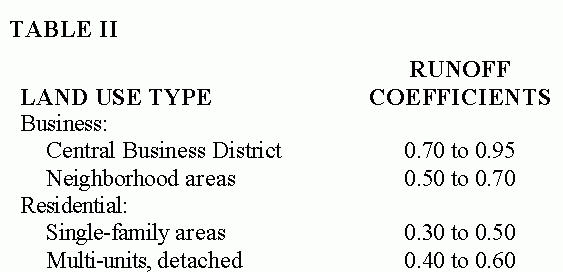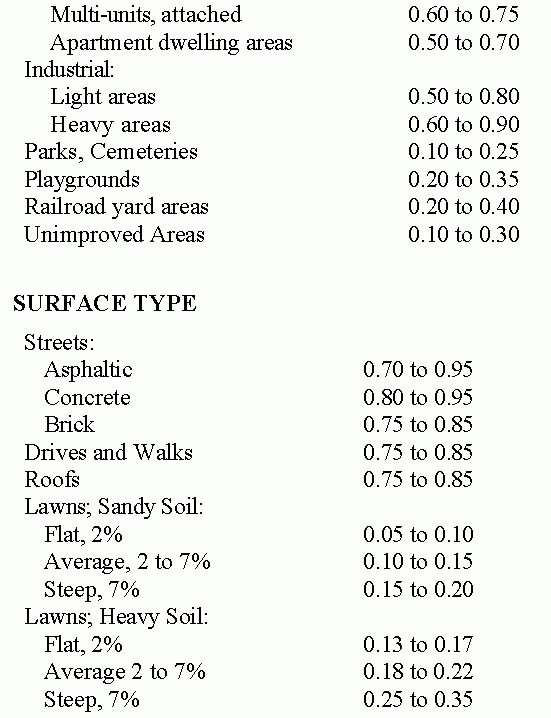a. No land area shall be developed by any applicant such that:�
1. The volume and rate of storm water runoff occurring from the property is increased over the volume and rate which occurs under existing predevelopment conditions.�
In those cases where the existing structures, buildings, and/or pavements is/are removed or razed, the existing conditions shall be considered "unimproved," for the purpose of this chapter.�
2. The drainage of the adjacent properties is not adversely affected.�
3. The existing drainage pattern of ditches, channels, and streams is not altered, nor their carrying capacities exceeded.�
4. Storm water runoff from impervious areas such as parking lots, driveways or loading zones, flows over or across sidewalks, or out of driveways, however, special attention may be given to those sites by the Director of Engineering, where topographic conditions make compliance in this regard exceedingly difficult.�
b. In order to accomplish the above objectives, the design of storm water drainage and storm water storage facilities may include: roof-top storage, oversized sewers with restricted outlet pipes, underground storage tanks, surface detention basins, french drains, planted swale areas, bermed areas, or where acceptable soil and ground water conditions exist, recharge basins, dry wells, porous pavement, or any other innovative techniques, or combination of the above as approved by the Director of Engineering (Copy of Graph on file in Office of City Clerk).�
c. Design of Storm Water Storage Facilities.�
1. On-tract storm water facilities shall be designed to contain the amount of storm water runoff, which is equal to the maximum difference in runoff between existing conditions and post development conditions.�
2. Either the rational method or the soil conservation service method as outlined in the Soil Conservation Service National Engineering Handbook, Section 4, Hydrology, shall be used for computing the volume and rate of runoff from existing and post development conditions.�
3. The amount of runoff shall be compiled using a design storm with a ten (10) year return frequency for Essex County. (See Graph on file in Office of City Clerk) The minimum initial time of concentration shall be ten (10) minutes.�
4. For computation with the rational method, published runoff coefficients which reflect land use and topography shall be used. Acceptable runoff coefficients currently in practice include, but are not limited to the following:�


5. A minimum acceptable outlet pipe from all storage facilities shall be eight (8) inches internal diameter, and be of material and class as approved by Title VII, the State Uniform Construction Code as adopted by the City. [7:1-1 et seq.]�
6. In the case of detention facilities utilizing porous media for ground absorption, such as dry-wells, porous pavement, or the like, the volume of porous media shall be large enough to contain the total volume of rainfall excess, as required under paragraph c., 1. of this section, within the voids. Ground absorption systems shall be used only where the infiltration rate of the receiving soil is acceptable as determined by percolation tests and performed under the guidelines and standards of N.J.A.C. 7:9 et seq. [State Department of Environmental Protection], and soil borings, or as determined by the Director of Engineering. Provisions shall be made to contain overflow of such systems on site or to surface drain the overflow in such a way as not to adversely affect any other property.�
�
7. If detention facilities utilizing surface impoundment, such as detention basins or rooftop storage, are used, sufficient volume to fully contain the total volume of rainfall excess shall be provided. The outlets of such facilities shall be designed to limit the maximum discharge rate of stormwater runoff to what occurs at the site under existing conditions and shall discharge in such a way as not to adversely affect any other property. If rooftop storage is proposed, the weight of the impounded water on the roof shall be accounted for in the structural design of the building and the roof shall be designed to provide maximum protection against leakage. If earth berms or dikes are used to create the impounding area, they shall be adequately stabilized and the slopes protected with vegetative cover, paving, or riprap to protect against failure or breaching.�
8. If a combination of different storm water detention techniques are used, the combined volume of the systems shall be large enough to fully contain the total volume of rainfall excess.�
9. Storm water detention facilities shall be maintained regularly by the owner to insure continual functioning of the systems at design capacity and to prevent the health hazards associated with debris buildup and stagnant water. In no case shall water be allowed to remain in any facility long enough to constitute a mosquito breeding, disease or any other type of health problem.�
10. Storm water conduits shall be designed with full flow velocities ranging from a minimum of two and one-half (2.5) feet per second to a maximum of ten (10) feet per second.�
11. All drainage and storage facilities shall be constructed to meet the requirements of the Director of Engineering.�
12. All storm water conduits must be connected to storm sewers wherever available, but in no case will storm water conduits be connected to sanitary sewers. In the event that the municipal system is surcharged even after storage facilities are designed, the Director of Engineering shall direct the point of connection or require such changes as are necessitated.�
(R.O. 1966 C.S. § 16:9-46; Ord. 6 PS F-A(S), 7-14-09 Exh. A)�